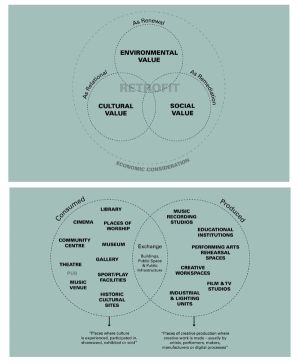Retrofitting for Cultural Infrastructure
WHY DO WE NEED TO CONSIDER RETROFIT FOR CULTURAL INFRASTRUCTURE?
Cultural and creative industries are essential to the UK’s success and the foundation for civic life. Retrofitting, as an approach, framework and strategy for cultural infrastructure can support sustainable development and promotion of the sector’s value against multiple environmental, cultural, social and economic pressures.
While new-build technologies are addressing embodied and operational carbon of buildings to meet the Paris Agreement target of becoming zero-carbon by 2050, there are few resources to support the adaptation of the estimated 80% of building stock that will have already been built and occupied by then.
The National Planning Policy Framework features three pillars of sustainable development: economic, social and environmental.1 Although existing strategies provide an environmental and economic case for retrofit, there is a lack of regulatory incentives for social and cultural impacts to be considered, which are particularly critical for cultural infrastructure. This includes the public benefits of heritage preservation, the need for accessibility improvements and the irreplaceable networks that nurture local skills, talent and sense of belonging.
Retrofit can be broadly defined as the regenerative upgrading of existing spaces. In determining the viability of retrofit for cultural infrastructure – buildings, facilities and public realm - there is a need for the holistic assessment of environmental, cultural and social factors for cultural organisations to make informed strategic decisions.
This report helps articulate the three values of retrofit - environmental, cultural and social - operating within the parameters of economic considerations, which should be considered for the future-proofing of our cultural infrastructure. It aims to bring greater clarity to the retrofit process for cultural organisations as well as recommendations for policy-makers and researchers.

With sustainable development becoming a major priority in architecture and design, retrofit is a word heard with increasing frequency. Alongside the need for high environmental performance, there is a demand for the provision of spaces that are equitable, heritage-sensitive, accessible and reflect the diverse needs of both their local community and an international population.
While providing essential clarity on the retrofit process, the fundamental purpose of this report is both to outline key recommendations for the Department for Culture, Media and Sport (DCMS) in supporting cultural retrofit projects across the UK, and to provide a practical guide for cultural organisations who are considering the holistic retrofit of existing cultural buildings or alternative premises.
The report, authored by DSDHA, has been commissioned, funded and coordinated by Future Observatory at the Design Museum, in partnership with the Arts and Humanities Research Council (AHRC); and supported by the DCMS via UK Research and Innovation (UKRI). This research was developed and produced according to UKRI’s initial hypotheses and output requests. Any primary research, subsequent findings or recommendations do not represent DCMS views or policy and are produced according to academic ethics, quality assurance and independence.